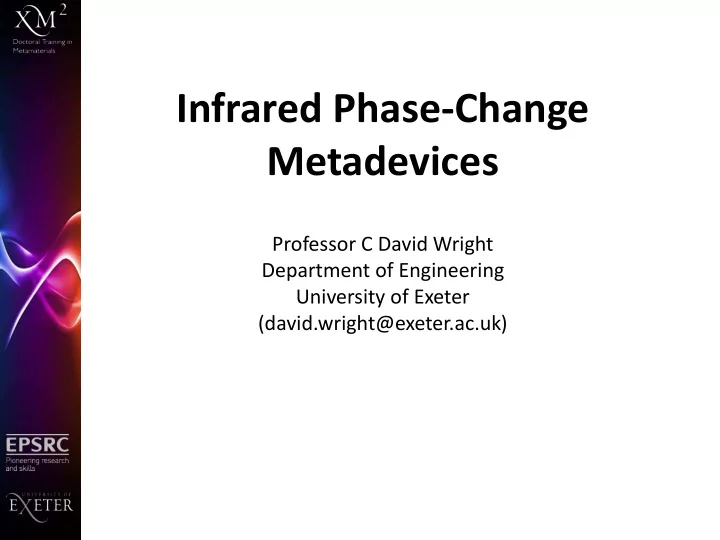

Infrared Phase-Change Metadevices Professor C David Wright Department of Engineering University of Exeter (david.wright@exeter.ac.uk)
Acknowledgements PhD students from Exeter’s CDT in Metamaterials Santiago García-Cuevas Carrillo Carlota Ruiz De Galarreta Liam Trimby Emanuele Gemo Exeter staff Collaborators from Dr Jacopo Bertolloti Southampton Dr Arseny Alexeev Prof Dan Hewak Dr Anna Baldycheva Dr Hasan Hayat Dr Yat-Yin Au Dr Karthik Nagareddy Collaborators from Bristol Collaborators from Oxford Prof Martin Cryan Prof Harish Bhaskaran Dr Maciej Klemm Dr Peiman Hosseini
Funding Acknowledgements University of Exeter EPSRC Centre for Doctoral Training in Metamaterials EPSRC WAFT Project (led by Harish Bhaskaran at Oxford) EPSRC ChAMP Project (led by Dan Hewak at Southampton) Office for Naval Research Global QinetiQ Dyson
What are phase-change materials ?
Chalcogenide phase-change materials What are phase-change materials? ✓ Fast transition time (ns) ✓ High electro-optical contrast ✓ Non-volatile Crystalline Amorphous Optical changes on phase-switching Electrical changes on phase-switching Conductivity Temperature (K)
Chalcogenide phase-change materials What are chalcogenides? Chalcogens – elements of group VIA of periodic table Chalcogenides – alloys of chalcogens with other elements Chalcogenide phase-change alloys – e.g. Ge 2 Sb 2 Te 5 – phase-change materials Transition-metal dichalcogenides – e.g. MoS 2 - 2D materials with bandgap
Existing uses of phase-change materials Re-writable optical discs - DVD-RW, DVD+RW, DVD-RAM - Blu-ray RE (100 Gbyte) Non-volatile electrical memory - High-end SSD replacement - Intel-Micron joint venture
What are metadevices ?
Phase-change metadevices Combine phase-change materials and optical metasurfaces to deliver new photonics functionality Conventional metasurfaces typically have patterned metal top layer, metal ground plane and dielectric spacer Optical response tailored by exploiting plasmonic resonances Response is fixed by design (shapes, sizes, thicknesses, materials) Example – broadband solar absorber See: A K Azad et al, Scientific Reports 6, 20347, 2016
Phase-change metadevices Phase-change meta-devices replace the (passive) dielectric with a phase-change layer - acts as switchable dielectric Optical response different for phase-change layer in amorphous and crystalline phases Switch between two phases optically or electrically Devices with tunable , switchable, re-configurable optical response • Tuned, re-configurable absorbers (modulators) • Beam steering with no moving parts • Tunable multispectral filters • Re-configurable lenses • Spatial light modulators • Moving holograms See: S G-C Carrillo et al., Optics Express 24, 13563 (2016) C Ruiz de Galarreta et al., Adv Funct Mater (submitted)
Examples of phase- change IR metadevices
Phase-change meta-absorbers/modulators Example – a near-infrared meta-absorber/modulator Device optimised for optimum modulation depth at 1550 nm by • varying width and spacing of top metal stripes and • varying thickness of GST and ITO layers MD = ratio of device reflectance for GST layer in crystal /amorphous phases See: S G-C Carrillo et al., Optics Express 24, 13563 (2016)
Phase-change meta-absorbers/modulators Simulated device reflectance spectrum (Au metal layers) Incident radiation non- coupled to structure MODULATION Incident radiation DEPTH coupled to structure Absorption (1550 nm) ~ 99% MD (1550 nm) ~ 76%
Plasmon-induced electric and magnetic dipoles Electric dipole Gold patch (and image) air Magnetic dipole air Gold layer Reflectance (a.u.) 1550 nm
Phase-change meta-absorbers/modulators Experimental devices (Al metal layers) Experimental reflectance spectra - starting phase amorphous - crystallised by scanned 405 nm laser - good agreement between simulated and actual spectra
Phase-change meta-absorbers/modulators Ex-situ optical switching is relatively easy In-situ electrical switching more attractive for real-world devices See poster by Santiago Garcia-Cuevas Carrillo - Phase-change meta-devices for near-infrared absorbers & modulators
Phase-change beam-steering meta-devices Here we control the optical phase of the reflected wave (cf. control of amplitude in absorber devices) 𝐭𝐣𝐨(𝜷 𝒔 ) = 𝐭𝐣𝐨(𝜷 𝒋 ) + 𝜠𝝔𝝁 𝟏 Generalized Snell’s Law 𝟑𝝆𝒆 Amorphous Crystalline
Phase-change beam-steering metadevices Super cell design Unit cell design See: C Ruiz de Galarreta et al., Adv Funct Mater (submitted)
Beam-steering meta-devices: Device Fabrication
Beam-steering metadevices: Device Fabrication See: C Ruiz de Galarreta et al., Adv Funct Mater (submitted)
Beam-steering metadevices: Device characterisation Simulated response Measured response λ = 1550 nm Measurements carried out at University of Bristol
Phase-change beam-steering metadevices Possible applications • LIDAR (autonomous vehicles, robotics) • Beam coupling (communications) • Modulation (cf. AO, LCD modulators) • Camouflage (deflection incoming beams) See poster by Carlota Ruiz de Galarreta - Beam steering and beam shaping phase-change metasurfaces working in the near infrared
Multispectral imaging phase-change metadevices See poster by Liam Trimby - Multispectral Imaging using Phase-Change Meta-Filters
Dielectric phase-change metadevices All devices so far have exploited plasmonic resonances in metals Plasmonic losses can be high Is there an alternative, low-loss approach? Yes – dielectric phase-change metadevices
Dielectric phase-change metadevices Efficiencies can be very high (80-90%) See poster by Arseny Alexeev - Tunable dielectric metadevices enabled by phase-change materials
Summary Phase-change materials used successfully for optical & electrical memories Optical metasurfaces used successfully to deliver flat thin-film optics By combining phase-change materials and metasurfaces, can deliver a wide range of new and improved optical/photonic functionality Possible devices include: • Tunable/reconfigurable absorbers and modulators • Beam steerers and beam transformers • Spatial light modulators • Reconfigurable lenses • Non-volatile and holographic displays Application areas include: • Imaging and sensing • Autonomous vehicles and robotics • Communications • Security and defence • Bio-medical instrumentation Can work over a wide range of wavelengths – visible, NIR, MIR
Recommend
More recommend